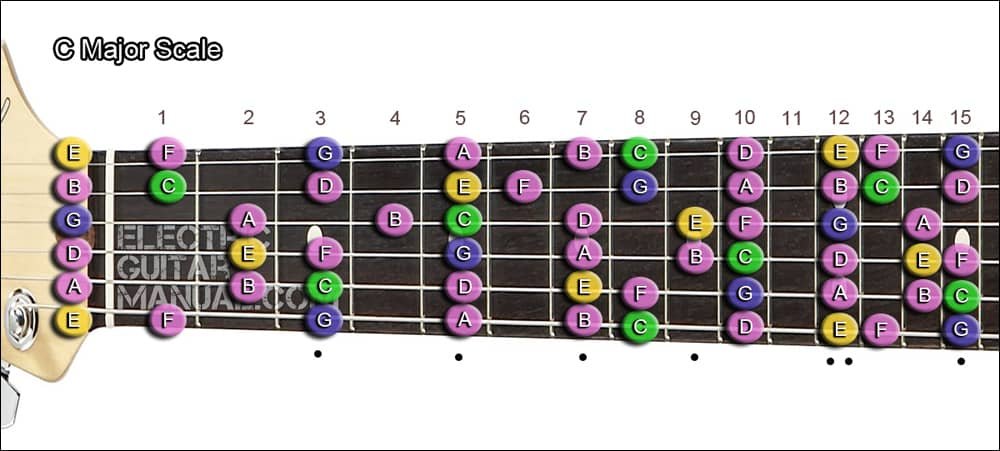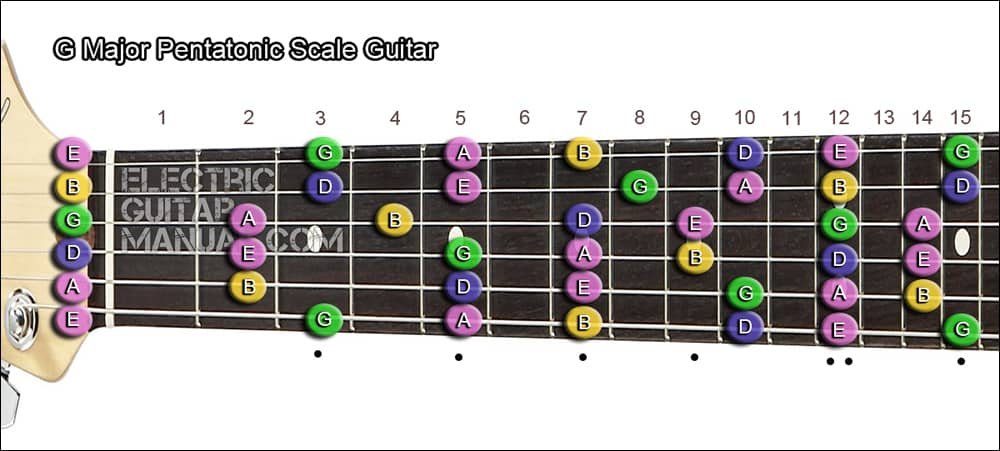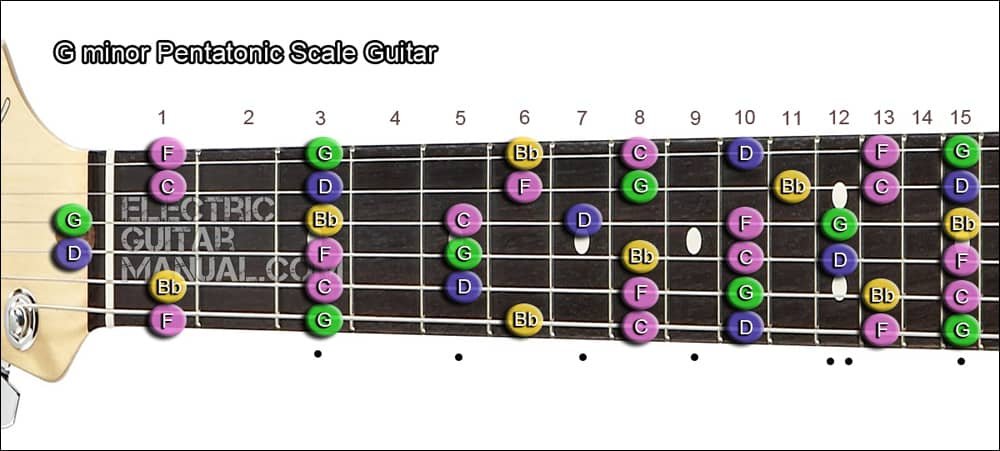
4 Beginner Guitar Scales
To begin with, I will tell you that in this article I will show you 4 different guitar scales, but in reality it is the same basic structure of a major scale, from which the rest of the scales flow. Later I will progressively explain why all scales are actually the same.
Although these guitar scales are the basic and main musical scales, for this same reason they are also the most widely used. These four scales that are part of the vast majority of guitar solos in many different musical genres would be:
- The Diatonic Major Scale, known simply as the Major Scale.
- The Natural Minor Scale simply named as the Minor Scale.
- And the Respective Pentatonics of the two scales mentioned above.
Guitar Scales Menu
Below you can find information about guitar scales, in this extensive menu in which you can find the appropriate scale, in the key you need.
Choose the Type of Guitar Scale You Need from the Menu. You will find the scale you are looking for in large graphics.
Guitar Scales: Major
Possibly the major scale is the first scale that is normally learned. Since we can mentally use the structure of the major scale on the guitar fingerboard, to develop other musical scales such as the minor scale.
In the example below you have the C Major Scale, but if you need another key you can visit the GUITAR MAJOR SCALE page.
Example:
Arrangement of the Notes of the C Major Scale (C), Distributed over the Entire Fretboard of the Guitar. The green circles mark the Tonic, the blue ones the Dominant or 5th, and the yellow ones the Median or 3rd. You can see how the notes colored in green, blue and yellow form C Major chords.
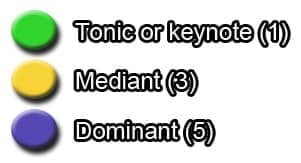
Guitar Scales: Minor
The natural minor scale has the same structure as the diatonic major scale, but starting its arrangement from the 6th note of the Major scale. This note known as the Relative minor. In the case of the C major scale, this note would be A.

The minor scale is one of the most used musical scales, even more than the major scale. Since much of the most popular songs in rock are in a minor key. But in addition, this scale is also used in major keys, so the minor scale has no competition in terms of versatility and use.
In the example below you have the G minor scale, but if you need another key you can visit the GUITAR MINOR SCALE page.
Major Pentatonic Scale
The Major Pentatonic Scale dispenses with the 4th and 7th notes, compared to the Diatonic Major scale. So this scale is made up of only 5 notes. Consequently, it is an easier scale to master than the major scale.
But this does not mean that the major pentatonic scale has stopped being used by the most famous guitarists. On the contrary, since this scale is one of the most popular, used in many genres such as Rock, Hard Rock, Blues, or Metal.
In the example below you have the G Major pentatonic scale, but if you need another key you can visit the MAJOR PENTATONIC SCALE page.
Example:
Minor Pentatonic Scale
The Minor Pentatonic Scale would be similar to the previous scale, but for use in minor keys. Although there are many occasions in which this scale is also used in major keys. This scale dispenses with the 2nd and 6th notes, compared to the natural minor scale.
The Minor Pentatonic Scale is one of the most used in guitar solos, even more than the major pentatonic scale, because it has a tonic that is not as decisive compared to the major scale.
In the example below you have the G minor pentatonic scale, but if you need other key you can visit the MINOR PENTATONIC SCALE page.
Example:
Which Guitar Scale to Use in Each Song?
To know how to use the guitar scales, we have to first know the key of the song we want to work on. If we have difficulty finding the key of a song, we can look up the key of a song on the internet, and problem solved.
It is very likely to find information about the key of a musical theme if we use internet search engines. We put the title of the song accompanied by the word key, and many times it comes out the first time.
The method would be very simple. For example, a song is in the key of D minor, and the scale to use for that song would be the D minor scale, or its Pentatonic.
As a simple method of initiation into the complex world of improvisation, we should try to finish the times in the colored notes. That is, the tonic in green, the third or third note of the scale in yellow, and the fifth in blue.
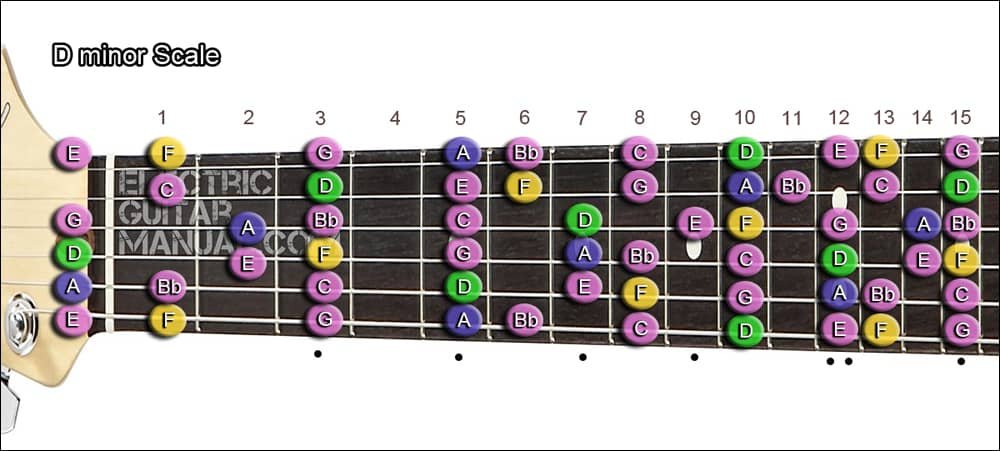
As we see, these colored notes form major or minor chords, depending on the scale or key that gives it its name. In the example case shown, they would be D minor chords. I can’t make it easier for you 😉
COMPLETE GLOSSARY of the Most Used Guitar Scales: Major, Minor, Pentatonic, and Blues Scales. THE BEST GRAPHICS with the Layout of the Notes on the Entire Fingerboard.
This is one of the topics that causes the most headaches for guitarists. But with this method of learning guitar scales, you will have no problems memorizing the distribution of the notes of a scale throughout the entire fretboard. Since on the other hand, the main musical scales have the same structure.
Definitely understand which guitar scale to use for each song, depending on the key of the musical theme in question. Improvise with your guitar on your favorite songs easily.
Guitar Scales: Major, Minor and Pentatonic
KNOW the Major, Minor, and Pentatonic Scales, and access the menu that will take you to the different keys of each scale. Enjoy the appropriate scale in a couple of clicks.
Relative scales are those that are made up of the same notes, and therefore of the same structure on the fingerboard. But obviously these are different scales with different keys. This is very useful for getting the most out of learning scales.
LEARN to play the different Modal Scales to take another step as a musician and guitarist. Furthermore, these scales all have the same structure. Something very convenient for your learning.
The blues scale is evidently one of the most used musical scales in the Blues genre. But don’t be confused, since this scale is also used in other musical genres such as Rock, or even Metal.
Harmonic and Melodic Minor Scales on Guitar
The Harmonic minor and Melodic minor scale in Seven Keys. If Neoclassical Metal is your thing, the harmonic minor scale is what you were looking for. On the other hand, if your style is Jazz, the melodic minor scale is the Holy Grail.

